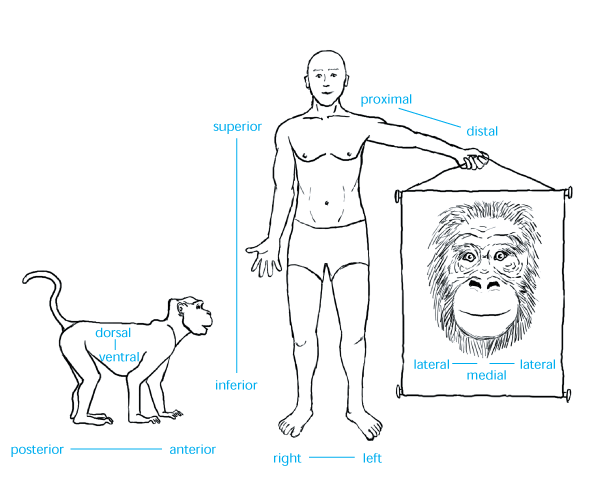A quick start on anatomical directions
Giving some basic definitions for the terms that anatomists use to talk about directions on the skeleton and body.
When talking about bones and teeth, we will need to use several terms to orient ourselves. Some of the terms are obvious, like right and left. Other intuitive terms can fail us, however. For example, we could use higher and lower to refer to parts of our arms, but these terms will be confusing if we lift our arms over our heads. Even left and right can cause confusion: sometimes we need to talk about the left surface of our right arm, for instance. For reasons like these, anthropologists use terms with specific anatomical meanings to talk about the positions of bones and features on them.
Humans are special compared to many vertebrates in having a vertebral axis that runs roughly up and down, at least while we are standing up. For this reason, a long tradition in human anatomy uses these terms:
Superior: Higher. The nose is superior to the mouth.
Inferior: Lower. The nostrils are most visible on the inferior aspect of the nose.
These terms are always used when referring to directions on the head. For the postcranial skeleton, we may also use cranial and caudal, which orient along the axis of the spine. For animals that don’t carry their spine in an upright or vertical position, cranial and caudal will always denote the same directions.
The vertebral axis is only one direction, and our bodies have two additional directions: front to back, and side to side. The terms for the front to back direction are:
Anterior: Toward the front. The nose is on the anterior side of the head.
Posterior: Toward the rear. The posterior side of the head is frequently covered in hair.
Dorsal: In humans, toward the back of the torso. The shoulder blades are dorsal to the ribs.
Ventral: In humans, toward the front of the torso. The navel is on the ventral aspect of the body.
In humans, dorsal and ventral are mostly synonymous with posterior and anterior, and the latter terms are often used. In animals with habitual postures that are different than ours, dorsal and ventral retain an anatomical meaning that is unchanged and thus prevent confusion.
Left and right are absolute terms instead of relative terms. These terms separate one half of the body from the other. The right arm will always be the right arm, and the right lung is right even though it is not as far right as the right arm.
To refer to the position of a feature relative to another, the following terms are used:
Medial: Closer to the midline, or dividing line between right and left halves, of the body. The neck is medial to the shoulder.
Lateral: Farther from the midline. The eye is lateral to the nose.
The limbs are special cases, because they can move a great deal relative to the spine. For the limbs, anterior, posterior, medial, and lateral are all relative terms used in reference to a particular limb position, called the anatomical position. For humans, the arms are in anatomical position when hanging at the sides of the body, palms forward, and the legs are in anatomical position in a normal standing posture, feet side by side. This means that the pinky side of the wrist is medial, and the thumb side is lateral. Superior and inferior are not used for the limbs at all. These terms are replaced by:
Proximal: Closer to the point of attachment with the torso. In other words, closer to the shoulder or the hip. The elbow is proximal to the wrist.
Distal: Farther from the point of attachment. The ankle is distal to the knee.

These terms can be somewhat confusing to learn, but they prevent a great deal of confusion in referring to bones and their features. The most common ones in this course will be anterior, posterior, superior, inferior, medial, lateral, proximal, and distal. Teeth and the hands and feet each have a few special directional terms, which will be introduced along with these anatomical areas.